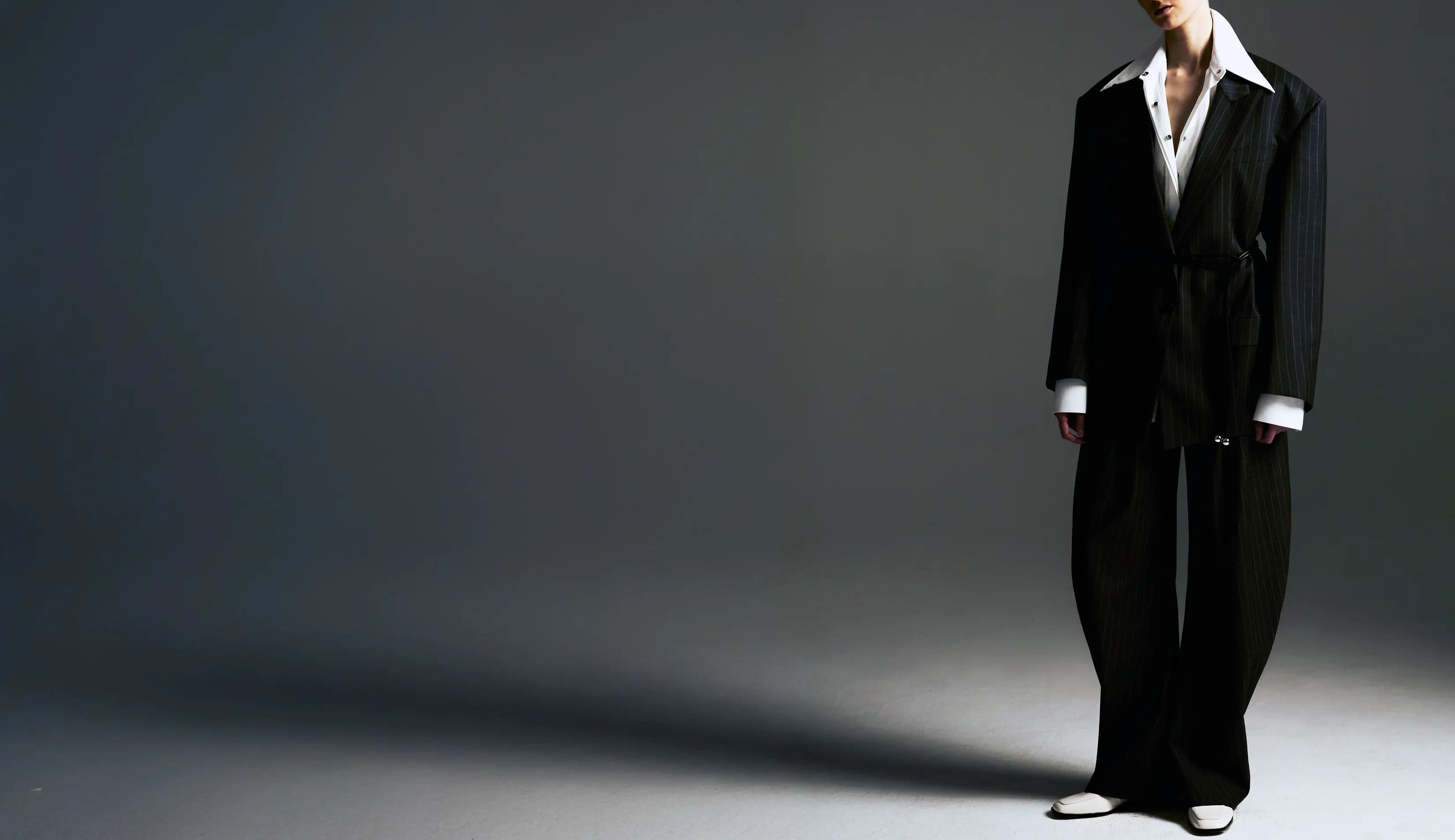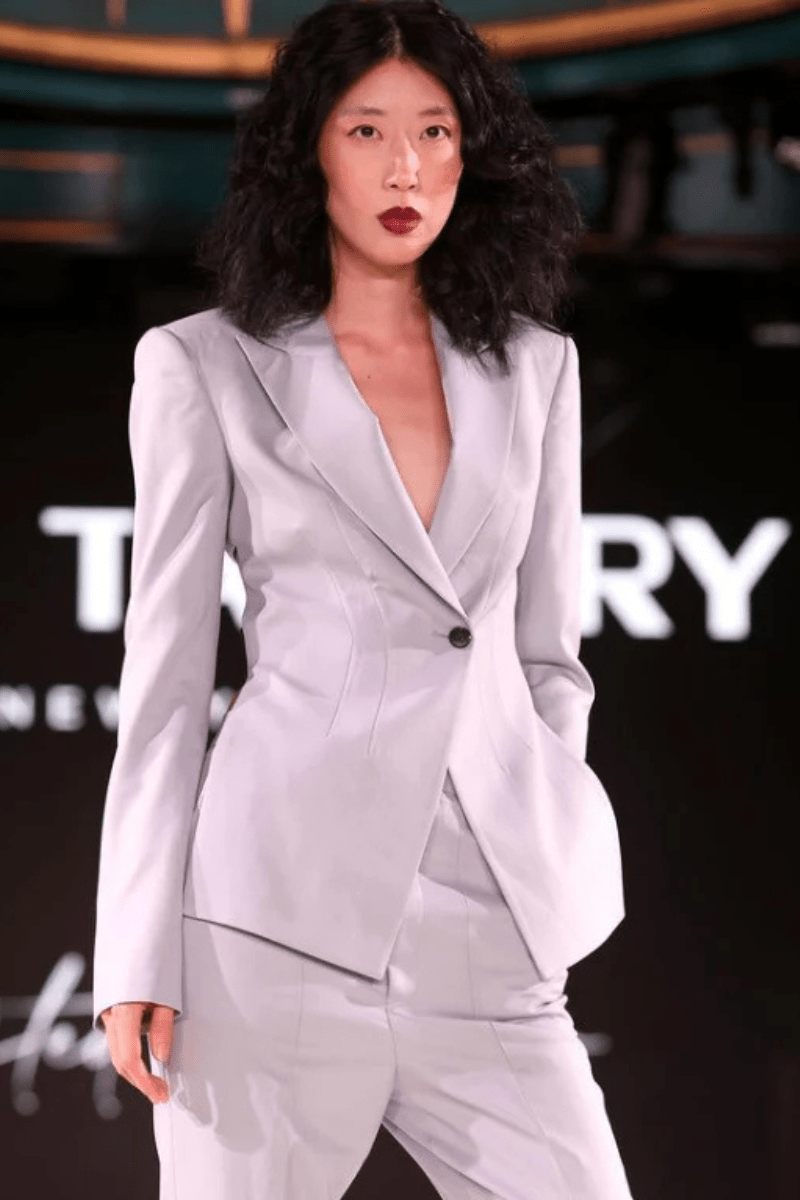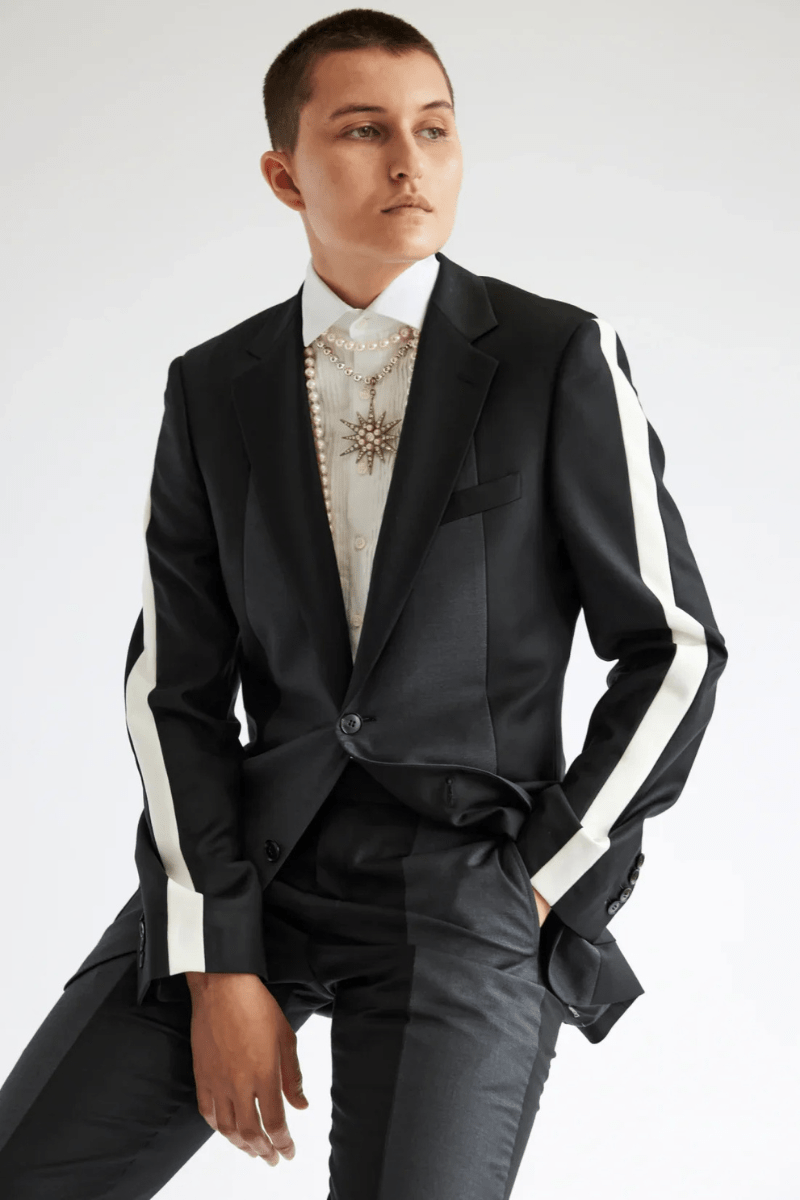The Architecture of Authentic Movement
The armscye construction visible in Zhang Ziyi's fitted costume demonstrates principles that would revolutionize contemporary suit making. Her garment accommodated extreme range of motion—sword work, acrobatic sequences, intricate fight choreography—while maintaining perfect shoulder line integrity. This wasn't achieved through loose fit or casual construction; it required sophisticated pattern drafting that followed anatomical logic rather than arbitrary style dictates.
Modern tailoring can learn from this approach. The typical suit jacket restricts shoulder movement because its armscye placement prioritizes visual appearance over functional performance. Wuxia costume construction, refined through decades of practical film demands, proves that technical precision can enhance rather than compromise aesthetic impact. The floating canvas technique used in superior bespoke work shares DNA with these costume internal structures—both create garments that move as extensions of the body rather than obstacles to natural motion.
Consider how Michelle Yeoh's character navigated complex action sequences while maintaining dignified presence. Her costume construction incorporated strategic ease placement—not the kind of poor fit that suggests inadequate tailoring, but calculated fabric distribution that allowed expansion and contraction without disrupting the overall silhouette. This represents the difference between clothing that fights the wearer and clothing that supports authentic self-expression.
Structural Intelligence: Lessons from Cinematic Demands
The princess seam construction evident in period Chinese formal wear provides exceptional waist definition while accommodating natural torso movement. When adapted to contemporary suiting, this technique creates clean lines without the binding sensation that transforms board meetings into endurance tests. The key lies in understanding how seam placement follows the body's natural curves rather than imposing artificial shape requirements—the same principle that allowed film actors to perform complex choreography without costume malfunctions.
Hand-canvassed construction, the hallmark of superior bespoke tailoring, operates on similar principles to the internal support systems visible in these cinematic costumes. Both prioritize flexibility within form, creating garments that maintain intended appearance while accommodating unpredictable real-world demands. The floating chest piece in a well-made jacket serves the same function as the internal structure systems in wuxia robes—providing support without creating pressure points that restrict breathing or movement.
Fabric selection in these films emphasized natural fibers with inherent recovery properties. Silk, linen, and high-quality cotton blends return to their original state after stress, maintaining appearance integrity throughout extended wear periods. This material consciousness contrasts sharply with contemporary formal wear that often prioritizes initial appearance over long-term performance. Professional wardrobes evolved past the wrinkle-prone synthetic blends of the early 2000s—formal wear construction should evolve accordingly. The discerning client recognizes that fabric selection determines whether garments enhance or restrict authentic professional presence throughout demanding schedules.
Cultural Movement as Technical Foundation
The relationship between cultural expression and physical freedom in wuxia cinema offers insights that extend far past entertainment value. These films emerged from traditions where clothing was expected to accommodate complex physical disciplines—martial arts, ceremonial movements, dance—without sacrificing aesthetic standards. The resulting construction techniques prioritize authentic functionality over superficial appearance, much like how Pearl Jam's raw authenticity separated grunge from hair metal's manufactured spectacle.
This approach stands in stark contrast to much contemporary formal wear, which treats the human body as a static display form rather than a dynamic system requiring support and accommodation. The difference becomes apparent the moment someone attempts natural movement while wearing poorly constructed formal attire—the constant adjustment, restricted gestures, careful movement patterns designed to avoid garment damage or discomfort.
Chow Yun-Fat's commanding presence in the film poster wasn't diminished by his costume; it was enhanced by construction that allowed authentic expression rather than artificial constraint. Modern tailoring can adopt this same foundational assumption, creating formal wear that amplifies rather than inhibits the wearer's natural authority and presence.
The Reset Button: Reimagining Construction Philosophy
Traditional Western tailoring developed during periods when formal occasions involved significantly less physical activity than contemporary professional environments demand. Today's networking events, presentation requirements, and social obligations require formal wear that transitions seamlessly across diverse situations without constant garment management or movement restriction.
The reset button mentality—borrowed from how wuxia costume construction allows characters to maintain perfect appearance regardless of physical demands—can inform modern formal wear durability and recovery. Garments constructed with this philosophy bounce back from daily wear stresses without showing fatigue or requiring extensive maintenance. Traditional wedding wear construction is the sartorial equivalent of using a BlackBerry in 2025—technically functional but fundamentally misaligned with contemporary performance requirements.
This isn't about creating casual clothing that looks formal; it's about applying advanced construction techniques that allow genuinely formal garments to perform at levels matching current lifestyle demands. The internal structure systems, seam reinforcement methods, and fabric handling techniques developed for demanding film work translate directly to civilian formal wear that maintains integrity under real-world conditions.
Structural Innovation: From Film Set to Boardroom
The costume departments working on major wuxia productions face challenges that mirror high-end tailoring: creating garments that appear flawless under scrutiny while performing reliably under stress. The solutions developed for film work—reinforced stress points, strategic ease placement, recovery-focused fabric selection—apply directly to formal wear construction for contemporary professionals.
Canvassing techniques used in these costumes often employ multiple layers of support materials, each serving specific functions within the overall structural system. This approach prevents any single element from bearing excessive stress while maintaining the garment's intended silhouette. Modern jacket construction benefits from similar systematic thinking, distributing structural responsibilities across multiple integrated components rather than relying on single-point solutions that create failure vulnerabilities.
The armscye construction in well-designed period costumes demonstrates how proper pattern drafting eliminates the shoulder restriction that plagues contemporary suits. By following natural shoulder lines rather than imposing artificial shape requirements, these garments allow unrestricted arm movement while maintaining clean shoulder presentation. This technique, applied to modern suiting, creates jackets that feel custom-fitted rather than constraining—the kind of structural precision that separates bespoke craftsmanship from mass production assembly.
Material Intelligence: Fabric as Performance Partner
Wuxia costume design treats fabric as an active partner in performance rather than mere decorative covering. The silk weights, weave structures, and finishing techniques selected for these garments all contribute to their ability to move gracefully while maintaining visual impact. This material consciousness should inform formal wear selection, where fabric choice determines whether a garment enhances or restricts the wearer's authentic presence.
The drape qualities that make these cinematic robes visually striking come from understanding how different fabric weights interact with gravity and movement. Heavier materials provide structure and impact, while lighter weights allow fluid motion and graceful transitions. Modern suiting benefits from similar weight distribution strategies, using varying fabric densities within single garments to achieve both structure and mobility.
Recovery properties become crucial when garments must maintain appearance integrity throughout extended wear periods. The natural fibers favored in period costume construction possess inherent resilience that allows them to return to original form after stress. Contemporary formal wear constructed with similar material priorities performs reliably across diverse wearing conditions without requiring constant adjustment or maintenance—the difference between clothing that supports professional effectiveness and clothing that becomes a distraction.
The Thick Skin Philosophy: Durability Through Design
The thick skin approach to garment construction—building resilience into fundamental structure rather than treating durability as an afterthought—appears throughout wuxia costume design. These garments must withstand choreographed combat sequences, environmental extremes, and extended filming schedules while maintaining flawless appearance for close-up photography and wide-angle action shots.
This philosophy translates to formal wear construction that anticipates and accommodates the stresses of contemporary professional life. Rather than creating delicate garments requiring careful handling, the thick skin approach produces formal wear that improves with use, developing character and patina that enhance rather than detract from overall appearance. Professional wardrobes evolved past the disposable fast fashion of the early 2000s—construction standards should evolve accordingly. The sophisticated professional recognizes that garment durability reflects not just quality consciousness, but strategic thinking about long-term wardrobe investment and authentic self-presentation.
Internal construction techniques borrowed from costume work—strategic reinforcement placement, stress-distribution systems, recovery-focused seaming—create formal wear capable of handling active professional and social schedules. The result is clothing that supports rather than restricts authentic presence and natural movement, allowing wearers to focus on their objectives rather than managing their garments.
Contemporary Applications: Bridging Tradition and Innovation
Modern tailoring can incorporate wuxia-inspired construction techniques without sacrificing contemporary aesthetic standards. The key lies in understanding underlying principles rather than copying surface elements—applying the structural intelligence that allows unrestricted movement while maintaining sophisticated visual impact.
Pattern drafting techniques that prioritize natural body movement create garments that feel custom-fitted rather than restricting. Seam placement that follows anatomical logic rather than arbitrary style requirements allows full range of motion without compromising silhouette integrity. These approaches produce formal wear that enhances the wearer's natural presence rather than creating artificial constraints that telegraph insecurity or discomfort.
The integration of performance-oriented construction with sophisticated styling creates formal wear that functions as impressively as it appears. This represents evolution rather than revolution—taking proven elements of traditional tailoring craft and enhancing them with techniques proven effective under demanding conditions. The result supports authentic self-expression rather than requiring constant accommodation and management.
Advanced Construction Methodologies: Cinema to Couture
The translation from film costume construction to high-end formal wear requires understanding the specific challenges each environment presents. Wuxia productions demand garments that maintain visual perfection through multiple takes, weather changes, and physical stress that would destroy conventional formal wear within hours. These requirements drive innovation in construction techniques that benefit contemporary professionals navigating similarly demanding schedules.
Double-faced wool construction, frequently employed in period costume work, creates reversible garments with exceptional durability and recovery properties. This technique prevents visible wear patterns while providing superior drape characteristics that maintain appearance integrity throughout extended use. Modern suiting can adopt similar approaches, creating garments that improve with age rather than showing signs of deterioration.
Bias-cut panel integration, visible in many wuxia costume designs, allows fabric to move with the body's natural stretch patterns rather than fighting against them. This construction method, when applied to jacket side panels or trouser inseams, eliminates the binding sensation that occurs when garments restrict natural movement. The result is formal wear that adapts to the wearer rather than requiring the wearer to adapt to the garment.
Floating lining systems represent another advancement borrowed from costume construction. Traditional formal wear often features linings attached at multiple points, creating restriction and preventing natural drape. Wuxia costume construction employs minimal attachment points, allowing the outer fabric to move independently while maintaining structural integrity. This technique produces garments that breathe with the wearer while preserving intended silhouette and appearance standards.
The Science of Sophisticated Movement
Understanding how fabric behaves under stress informs both wuxia costume design and contemporary formal wear construction. Natural fibers possess memory properties that allow them to return to original form after stretching or compression. Synthetic blends, while offering certain practical advantages, often lack this recovery capability, leading to permanent deformation and appearance degradation over time.
The weight distribution principles employed in period costume construction create garments that hang properly regardless of the wearer's posture or movement patterns. Strategic placement of heavier materials in specific pattern pieces provides stability without creating bulk or restriction. This approach allows for clean lines and sophisticated appearance while accommodating the natural variations in human movement and posture.
Ease calculation in wuxia costume construction considers not just static measurements, but dynamic requirements for extreme range of motion. Modern formal wear benefits from similar calculation methods, providing adequate ease for natural movement without creating the loose fit that suggests poor tailoring. The balance between fitted appearance and functional performance requires technical expertise that separates superior construction from conventional approaches.
Future Implications: Movement as Design Priority
The lessons from wuxia costume construction suggest that formal wear design should prioritize authentic functionality alongside aesthetic impact. As professional and social environments continue evolving, demand for formal wear that performs reliably across diverse situations will only increase. The networking event that transitions from cocktail reception to outdoor terrace to transportation logistics requires garments that adapt seamlessly rather than becoming liability concerns.
This shift requires rethinking fundamental assumptions about formal wear construction—moving from static display priorities toward dynamic performance requirements without sacrificing sophistication or visual impact. The techniques developed for film costuming provide proven approaches for achieving both objectives simultaneously, much like how the best grunge bands maintained musical complexity while achieving mainstream accessibility.
The result represents formal wear that truly serves its wearer rather than requiring constant accommodation. This alignment between garment capabilities and lifestyle demands creates clothing that enhances rather than restricts authentic self-expression and professional effectiveness. Contemporary formal wear informed by these construction principles offers wearers the freedom to move naturally while maintaining impeccable presentation standards.
Consider the commanding presence evident in that Crouching Tiger, Hidden Dragon poster—four performers whose costumes enhanced rather than constrained their individual authority. Modern formal wear, constructed with similar attention to functional performance, can provide contemporary professionals with the same advantage: clothing that amplifies authentic presence rather than creating artificial limitations.
The floating elegance that defined cinematic martial arts can inform how contemporary tailoring approaches the challenge of creating formal wear that performs as beautifully as it appears. In both contexts, the goal remains consistent: garments that enhance human capability rather than limiting it, allowing wearers to navigate their environments with grace, confidence, and unrestricted authenticity. This represents not just improved functionality, but a fundamental shift toward clothing that supports rather than constrains individual expression and professional effectiveness.




